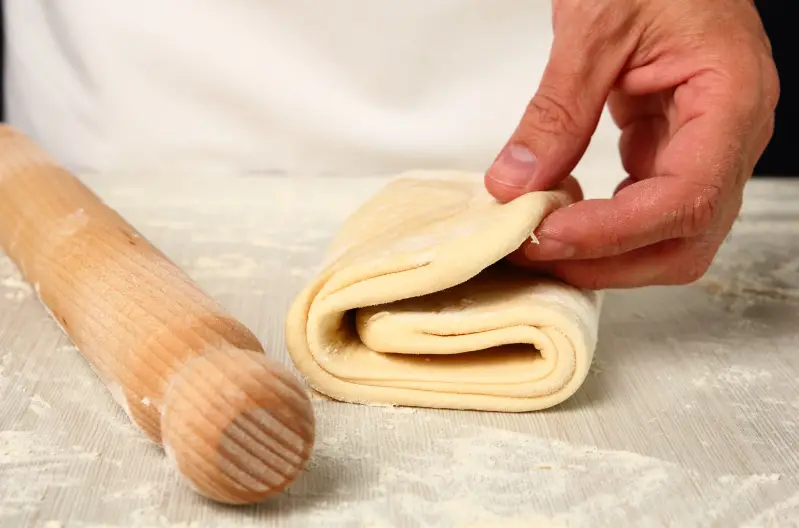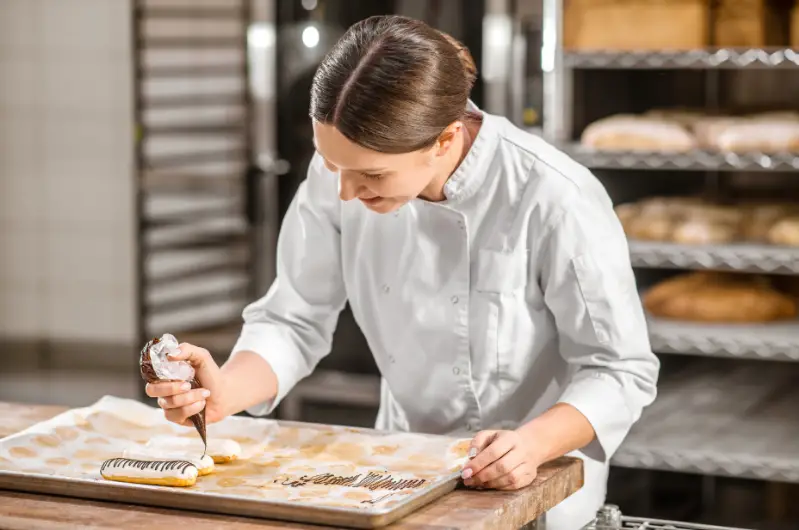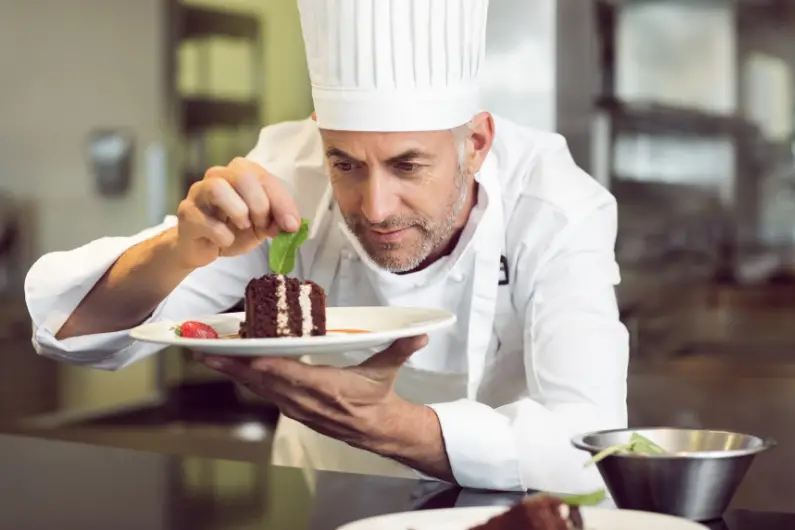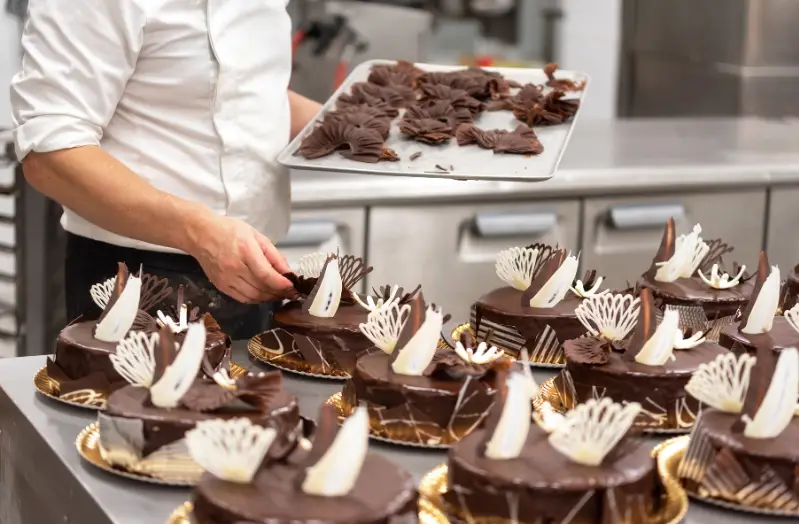Today, pastry is a global culinary art form that encompasses a wide range of sweet and savoury delights. It continues to evolve with new ingredients, techniques, and creative interpretations, making it a beloved and integral part of international cuisine.
But how did it all begin? From humble beginnings in ancient civilisations to the grandeur of modern culinary artistry, pastry’s history and the pastry chef’s role have followed a fascinating trajectory.
This article reflects on how pastry arts began, the history of the pastry chef, and how their role evolved in the kitchen brigade system of classical French cuisine from simple origins to revered specialists in creating the exquisite and diverse world of pastries and desserts we know today.
Another related read is on interesting facts about pastry chefs in our article on the importance of pastry chefs in society.
Table of Contents:
- The History and Origin of Pastry.
- The History and Origin of Puff Pastry.
- The History and Origin of Pastry Chefs.
- The Most Famous Pastry Chefs in History and to Date.
- Who Is Considered the Father of Patisserie?
- Who Is Considered the Father of Modern Pastry?
- Who Was the First Pastry Chef in History?
- The Most Famous Pastry Creations by Marie-Antoine Carême.
- The Pastry Chef Position as it Evolved in the Brigade System.
The History and Origin of Pastry.
The history and origin of pastry can be traced back thousands of years, with its evolution being influenced by various cultures and culinary traditions.

Here’s a brief overview of the history of pastry:
Dates to Ancient Civilizations: Pastry has ancient origins, dating to civilisations like the Egyptians and Greeks. In ancient Egypt, pastry-like recipes were made using a simple mixture of flour, water, and fat. The Greeks also had early pastry recipes, including sweet and savoury pastries filled with honey, nuts, and fruits.
Romans Influenced Pastry Techniques: The Romans further developed pastry-making techniques during their expansive rule. They introduced the concept of layered pastry dough, which would later evolve into what we know as puff pastry. Romans enjoyed sweet and savoury pastries, including versions filled with meat, cheese, and honey.
Pastry-Making Became Popular in Medieval Europe: Pastry-making continued to evolve in medieval Europe, with butter becoming more prevalent. The Crusaders are believed to have brought back phyllo dough, a thin pastry dough, from their travels in the Middle East. Pastries became popular in European courts and were used to showcase culinary skills and artistic creativity.
Renaissance and French Influence Refined and Elevated Pastry to an Art: During the Renaissance, pastry techniques became more refined, and the French played a significant role in elevating pastry to an art form. The French pastry tradition, emphasising precision, intricate decorations, and layered doughs, laid the foundation for modern pastry.
18th and 19th Centuries Saw Mass Pastry Products: Pastry gained further popularity in the 18th and 19th centuries by publishing cookbooks featuring elaborate pastry recipes. The Industrial Revolution introduced mass-produced pastry products, making them more accessible to a broader audience.
Continued Innovation in the 20th Century and Beyond: In the 20th century, pastry continued to evolve with innovations like frozen pastry dough and the popularisation of French pastries like croissants and eclairs. Pastry chefs around the world began experimenting with flavours and techniques, leading to the creation of modern, diverse pastries.

The History and Origin of Puff Pastry.
Puff pastry is a versatile and beloved pastry with a long and rich history. It is a rich and delicate pastry made of many thin alternating layers of dough and fat. This lamination gives puff pastry a light, crispy, and flaky texture upon baking.
While the exact origin of puff pastry is unclear, it is believed to have originated in France in the 17th century by French painter and apprentice cook Claude Gelée, in about 1645, when he accidentally created a laminated dough. It has since become a staple in French and international cuisine.
Listed below are some interesting points on the origin and history of puff pastry:
The oldest known recipe for puff pastry in France was written in a charter by bishop Robert of Amiens in 1311, but it is unclear whether this recipe used the same technique as modern puff pastry.
The techniques for making puff pastry continued to evolve in France during the 18th century. French pastry chefs, including Marie-Antoine Carême, were crucial in refining and popularising puff pastry.
Puff pastry gained widespread popularity in Europe during the 19th century. It became a staple in French cuisine and was used in various sweet and savoury dishes, including classic pastries like mille-feuille and vol-au-vent.
In the modern era, puff pastry is a fundamental component of many international cuisines, and it is used to create a wide range of sweet and savoury dishes, from tarts and quiches to palmiers and turnovers.
Commercially prepared puff pastry sheets and blocks are widely available, making them accessible to home cooks and professional chefs alike.
The History and Origin of Pastry Chefs.
The history and origin of pastry chefs can be traced back to ancient civilisations, but the role of a pastry chef as we know it today has evolved over centuries. Pastry chefs today are highly skilled culinary professionals who specialise in creating sweet treats, including pastries, cakes, and chocolates.
Here is a brief overview of the origin and history of pastry chefs:
Ancient Origins of Basic Pastry Making by Pastry Makers.
Pastry-making has ancient origins, with early civilisations like the Egyptians and Greeks creating rudimentary pastries made from essential ingredients like flour, water, and fat.
In ancient Rome, individuals known as “pastillarii” were responsible for making pastries and sweets. These early pastry-makers laid the foundation for future developments in the art of pastry.
Medieval and Renaissance Times: Pastry Becomes an Art Form.
During the Middle Ages in Europe, pastry-making evolved, and pastries became an essential part of feasts and banquets in the courts of nobility.
The Renaissance saw the refinement of pastry techniques, with the French in particular, contributing significantly to the art of pastry. French pastry chefs developed intricate pastries and confections, elevating pastry into an art form.
The Formation of Guilds for Bakers and Pastry Chefs.
In the late Middle Ages and the Renaissance, guilds or associations of bakers and pastry chefs were established in Europe. These guilds set standards for the quality of pastries and helped regulate the profession.
Pastry chefs during this period were often part of the same guilds as bakers but had specialised skills in creating delicate pastries and desserts.
18th and 19th Centuries: Pastry Chefs Gain Recognition.
The 18th and 19th centuries saw the publication of cookbooks that featured elaborate pastry recipes. Pastry chefs gained recognition for their skills in creating intricate and artistic desserts.
The Industrial Revolution introduced innovations such as mass-produced pastry products, making pastries more accessible to a broader audience.
Modern Era: The Pastry Chef Role Continues to Evolve.
In the 20th and 21st centuries, the role of a pastry chef has continued to evolve. Pastry chefs are now recognised as specialised culinary professionals with expertise in creating a wide range of sweet and savoury pastries, desserts, and confections.
Modern pastry chefs work in various settings, including restaurants, hotels, bakeries, and patisseries, and are known for their creative flair, innovative techniques, and diverse flavour combinations.

The Most Famous Pastry Chefs in History and to Date.
Several pastry chefs have left an indelible mark on the world of pastry and dessert-making throughout history and have inspired many others to pursue careers in pastry arts. Their innovative techniques, creativity, and contributions to the culinary arts have earned them recognition and acclaim.
Here are some of the most famous pastry chefs in history:
Antonin Carême (1784-1833): Often referred to as the “King of Chefs and the Chef of Kings,” Carême was a pioneering French pastry chef. He created extravagant and elaborate pastry and dessert creations for European royalty, and his culinary innovations, including new pastry techniques and the development of iconic pastries like croquembouche, continue to influence pastry chefs today.
Auguste Escoffier (1846-1935): a French chef and culinary legend, Escoffier made significant contributions to pastry and cuisine. He modernised and simplified pastry techniques, elevating pastry arts to new heights. He is known for his role in popularising desserts like Peach Melba and Melba toast.
Gaston Lenôtre (1920-2009): A prominent French pastry chef and entrepreneur, Lenôtre founded the renowned Lenôtre pastry and culinary school. His innovative creations and elegant presentations revolutionised pastry and he is credited with inventing the opera cake and popularising the macaron.
Ciro Macchi (1912-1981): An Italian pastry chef known for his exquisite pastries and desserts, Macchi’s creations were celebrated worldwide. He was particularly famous for his work with chocolate and gelato.
Pierre Hermé: Often referred to as the “Picasso of Pastry,” Hermé is a modern-day French pastry chef renowned for his innovative flavour combinations and artistic dessert creations. He has been recognised worldwide for his macarons, chocolates, and pastry boutiques.
Gaston Lenôtre (1920-2009): A French pastry chef and founder of the Lenôtre culinary empire, Gaston Lenôtre is known for his classic French pastries and desserts.
Joël Robuchon (1945-2018): A celebrated French chef, Robuchon was known for his culinary expertise in cuisine and pastry. He was renowned for his innovative desserts, and his restaurant, Jamin, held three Michelin stars for many years.
Gale Gand (1955-present): An American pastry chef and television personality, Gale Gand is known for her classic American desserts and pastries.
François Payard (1966-present): A French pastry chef who has worked in some of the world’s most prestigious kitchens, François Payard is known for his classic French pastries and desserts.
Elizabeth Falkner (1966-present): An American pastry chef and television personality, Elizabeth Falkner is known for her innovative and playful desserts.
Lorraine Pascale (1972-present): A British pastry chef and television personality, Lorraine Pascale is known for her simple and elegant desserts.
Duff Goldman (1974-present): An American pastry chef and television personality, Duff Goldman is known for his creative and whimsical cake designs.
Hironobu Fukano (1974-present): A Japanese pastry chef and owner of the pastry shop Le Chocolat de H, Hironobu Fukano is known for his unique and creative chocolate creations
Christophe Michalak: A contemporary French pastry chef, Michalak has gained international acclaim for his creative and visually stunning desserts. He was named the World Pastry Champion in 2005 and has published numerous pastry cookbooks.
Claire Clark: An influential British pastry chef, Clark is known for exceptional pastry and dessert creation skills. She has received accolades for her work in renowned restaurants and was the first female pastry chef to earn a Michelin star in the UK.
Jessica Préalpato (1984-present): A French pastry chef and winner of the World’s Best Pastry Chef award in 2019, Jessica Préalpato is known for her innovative and minimalist dessert.
Cedric Grolet (1985-present): A globally renowned French pastry chef whose talent has redefined the art of pastry-making. He is particularly famous for his intricate fruit-based pastries and trompe-l’oeil desserts that often resemble real fruits. Grolet was named “The World’s Best Pastry Chef”in 2018.
Who Is Considered the Father of Patisserie?
Antonin Carême (1784-1833) is often considered the “father of patisserie” or “pastry architecture.” Carême, a French chef and culinary pioneer, played a pivotal role in shaping the modern art of pastry and is credited with elevating pastry-making to new heights during the 19th century.
His legacy continues to inspire pastry chefs and dessert enthusiasts worldwide. Antonin Carême’s contributions to the art of patisserie remain a testament to the creativity and craftsmanship of pastry-making in the culinary world.
Carême’s contributions to patisserie and the culinary world include:
Innovative Techniques: He developed innovative pastry techniques, including the creation of intricate decorations, the refinement of puff pastry, and the invention of new pastry shapes and designs.
Pastry Architecture: Carême was known for his grandiose pastry creations, often resembling architectural marvels. He crafted elaborate sugar sculptures, including towering pièces montées (centrepiece displays made of sugar), and adorned royal banquets and celebrations.
Popularisation of Desserts: He was crucial in popularising a wide range of desserts, including classics like éclairs, mille-feuille, and napoleons. Many of these creations are still enjoyed today.
Royal Patronage: Carême served as the personal chef of various European royalty, including Napoleon Bonaparte, King George IV of England, and Tsar Alexander I of Russia. His creations graced the tables of the aristocracy and helped establish French cuisine as a pinnacle of gastronomy.
Cookbooks: He authored several influential cookbooks, including “Le Patissier Royal Parisien” and “Le Patissier Pittoresque,” documenting his pastry techniques and recipes, making them accessible to future generations of pastry chefs.
Who Is Considered the Father of Modern Pastry?
Gaston Lenôtre (1920-2009) is often regarded as the “father of modern pastry.” This renowned French pastry chef and entrepreneur played a pivotal role in revolutionising and modernising the pastry world.
Lenôtre’s innovative approach to pastry-making and commitment to quality and artistic presentation has left an indelible mark on the field. His legacy lives on through his culinary school, his influence on global pastry chefs, and his continued appreciation for the beauty and flavour of modern pastry creations.
Gaston Lenôtre’s contributions to modern pastry include:
Simplified Techniques: Lenôtre simplified and modernised pastry techniques, making them more accessible to professional chefs and home bakers. His emphasis on precision and methodical processes helped lay the foundation for modern pastry education.
Artistic Presentation: He introduced creative presentation into pastry, emphasising the aesthetic appeal of desserts. His creations were known for their elegant and visually stunning designs, which elevated pastry to an art form.
Innovative Pastries: Lenôtre was known for inventing and popularising new pastries and dessert concepts. He is credited with creating the opera cake, a layered dessert with a sophisticated flavour profile, and his work developing the macaron.
Culinary Schools and Education: Lenôtre founded the prestigious Lenôtre culinary school, which has trained generations of pastry chefs and culinary professionals. His commitment to education helped shape the future of pastry arts.
International Influence: He expanded his pastry empire internationally, with Lenôtre pastry boutiques and culinary schools established worldwide, further disseminating his vision of modern pastry.
Who Was the First Pastry Chef in History?
While it is difficult to pinpoint the exact first pastry chef, Antonin Carême is widely considered to be the first great Master of Pastry making in modern times. He is credited with bringing pastry into the world of haute cuisine.
Carême is widely considered to be the first ‘celebrity chef’, bringing pastry into the world of haute cuisine.
As noted, Carême was known for his elaborate and decorative pastry creations, including towering centrepieces of sugar and marzipan.
Today’s pastry chefs are highly skilled culinary professionals who specialise in creating sweet treats, including pastries, breads, cakes, candies, and chocolates.
Pastry chefs require specialised training in pastry arts, which includes courses in baking, pastry techniques, chocolate work, sugar work, and cake decorating. They may also complete an apprenticeship or work under a master pastry chef to gain practical experience and mentorship.
If you would like to learn more about a pastry chef, you can start with our article on the A-Z of being a pastry chef.
The Most Famous Pastry Creations by Marie-Antoine Carême.
Marie-Antoine Carême, a renowned French pastry chef and culinary artist of the 19th century, was celebrated for his extravagant and artistic pastry creations. His works graced the tables of European royalty and aristocracy. While many of his creations were documented in his books and menus, some of the most famous pastry creations attributed to Carême include:
Pièces Montées: Carême was famous for his pièces montées, which were elaborate and towering centrepieces made of sugar and pastry. These sculptures often featured architectural and fantastical designs, including castles, temples, and pyramids.
His pieces montées were showcased at grand banquets and celebrations, and they demonstrated his exceptional skills in sugar artistry.
Croquembouche: Carême is often credited with popularizing the croquembouche, a traditional French dessert. It consists of cream puffs (choux pastry) filled with pastry or whipped cream, stacked into a conical shape, and bound with caramelised sugar. Croquembouche remains a centrepiece at weddings and special occasions in France and beyond.
Napoleon (Mille-Feuille): Carême’s interpretation of the mille-feuille, known as the Napoleon, became an iconic pastry. It features layers of crisp puff pastry alternated with layers of pastry cream, often topped with a glossy fondant icing. The delicate layers and creamy filling showcase his mastery of pastry techniques.
Eccles Cake: Carême is said to have introduced the Eccles cake to France. This British pastry is flaky and filled with spiced currants, sugar, and butter. Carême’s version added sophistication to the classic recipe.
Baba au Rhum: Although not invented by Carême, he contributed to popularising the baba au rhum in France. This dessert is a small yeast cake saturated with rum or other liqueurs and often served with whipped or pastry cream.
Vol-au-Vent: Carême’s influence extended to savoury pastries, including the vol-au-vent. This pastry consists of a hollow, flaky puff pastry case typically filled with a creamy seafood or chicken filling. Carême’s version showcased his expertise in pastry construction and presentation.
The Pastry Chef Position as it Evolved in the Brigade System.
The modern position of the pastry chef, as it exists today, evolved through the traditional brigade system in classical French cuisine. This evolution reflects the growing importance of pastry and dessert-making in culinary arts.
This specialisation has led to the creation of exquisite and artistic desserts that highlight worldwide dining experiences.
The pastry chef is one of the critical roles within this system. Here’s how the role of the pastry chef evolved historically within the brigade system:
Escoffier refines the Brigade System: The hierarchical structure used in professional kitchens to organise and streamline operations originated in the 19th century in France.
Georges Auguste Escoffier, a renowned French chef of the late 19th and early 20th centuries, played a pivotal role in refining the brigade system. He introduced a more organised and hierarchical kitchen structure that divided kitchen staff into specific roles and responsibilities.
Creation of the Garde Manger: In Escoffier’s system, the pastry chef was initially part of the “garde manger” station, responsible for cold food preparation, including salads, appetisers, and desserts.
This role was sometimes known as the “entremetier,” as it involved preparing entrements, often sweet or savoury dishes served between courses.
Elevation of the Pastry Chef: Over time, the pastry chef’s role evolved and gained more recognition. As pastry and dessert-making techniques became more refined and elaborate, pastry chefs began to specialise in creating intricate desserts and pastries, separating themselves from the garde manger station.

Establishment of the Pastry Station: Pastry chefs were given their own designated station within the kitchen, known as the “pâtisserie.” This station was responsible for creating a wide range of desserts, pastries, and baked goods, both sweet and savoury.
Expansion of Responsibilities: As the art of pastry-making continued to evolve, pastry chefs took on additional responsibilities, such as developing dessert menus, creating signature desserts, and overseeing the pastry team.
Modern Pastry Chef Role: Today, the role of the pastry chef is highly specialised and respected within the culinary world. Pastry chefs are known for their expertise in creating a wide array of sweet and savoury pastries, desserts, and confections. They often lead pastry teams and contribute to menu planning and restaurant or bakery operations.



